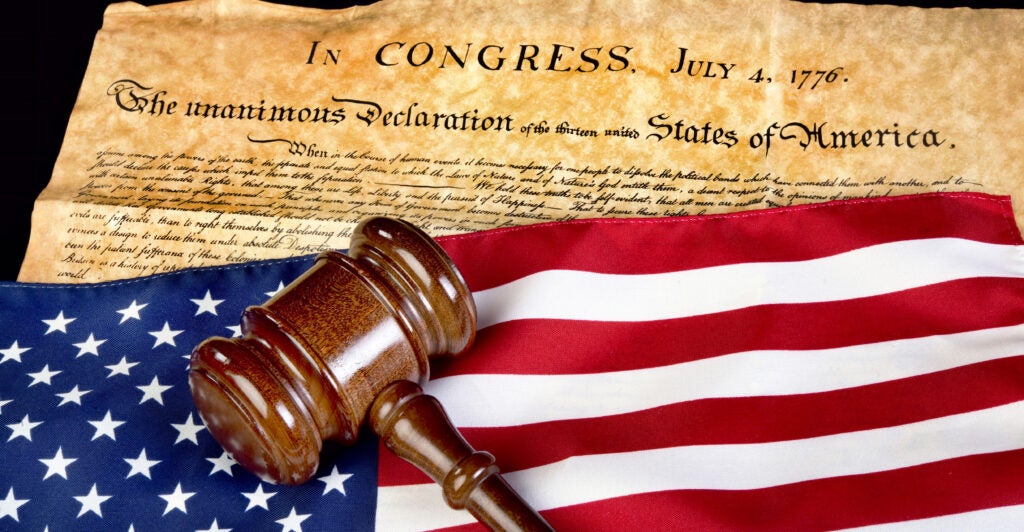To hear Vice President Kamala Harris tell it, the Supreme Court’s decision this summer to curb the federal bureaucracy’s authority to interpret vague laws so as to favor giving itself more power threatens everything from clean water and air, accessible health care, and sound financial markets to safe products and worker safety.
Well, don’t believe everything you hear.
The court’s decision doesn’t spell doom for medicine, industry, or the environment, but it is important for a different reason; namely, the separation of powers and an important check on government power.
In schools that still teach civics, kids learn that the three branches of government have different jobs: The legislative branch makes the law, the judicial branch interprets it, and the executive branch enforces it. That separation of power, America’s Founders said, protects our freedom by preventing too much power from ending up in too few hands.
At least that’s the theory. The separation of powers works only if the branches actually stay in their own lanes. The Supreme Court’s June 28 decision in Loper Bright v. Raimondo was a big step toward making that happen.
More than ever, the rules and regulations that govern our lives come from bureaucrats in powerful executive branch agencies. Implementing Congress’ statutes is not as simple as delivering a package to a particular address. Sometimes laws are unclear, and figuring out what Congress meant by what it enacted may take some work. How can we make sure that agencies don’t cross the line from interpreting what Congress meant to changing statutes altogether?
The Supreme Court blurred that line in a 1984 decision, Chevron v. National Resources Defense Council, by requiring that courts must accept “permissible” agency interpretations of statutory provisions that are “ambiguous” or “silent” about a particular issue.
Needless to say, those interpretations are in the eye of the bureaucratic beholder. The upshot of Chevron is that bureaucrats will often have almost free rein to define their own power and how to use it.
Loper Bright, in which the Supreme Court overruled Chevron, is a good example of how this paradigm can go wrong.
In 1976, Congress enacted a statute to manage the coastal fishery industry. The National Marine Fisheries Service implements this statute through regional fishery management councils. The statute allows the agency to require that “one or more observers be carried on board” domestic vessels for data collection and to require that two categories of such vessels bear the cost of those observers, which can top $700 per day.
The agency, however, began requiring that fishing vessels outside those categories also pay for observers, and Atlantic herring fishermen sued. The lower courts, citing Chevron, upheld the regulation, but the Supreme Court disagreed. Chief Justice John Roberts, writing for the majority, explained that America’s Founders designed a system in which the “interpretation of the laws” would be the “proper and peculiar province of the courts.”
Don’t get us wrong. One of us worked in the U.S. Senate for a long time and saw how the legislative sausage is made. Congress enacts statutes with vague or unclear language, without defining important terms or answering key policy questions. It’s almost as if Congress figures that unelected bureaucrats will finish the job of lawmaking for them. Chevron, in fact, practically invited them to do so.
Article III of the Constitution, however, forecloses that option by assigning the “the judicial Power of the United States [to] one supreme Court, and in such inferior Courts as the Congress may from time to time ordain and establish.” Interpretation of statutes—that is, determining what a legislature meant by what it enacted—is a core element of judicial power.
The point is that, as the Supreme Court put it in Marbury v. Madison, it is “emphatically the province and duty of the judicial department to say what the law is.”
Chevron turned that design on its head. In his concurring opinion in Loper Bright, Justice Clarence Thomas explained that the deference required by Chevron “compromises [the] separation of powers” by both “curb[ing] the judicial power afforded to courts” and “expand[ing] agencies’ executive power beyond constitutional limits.”
That obviously does not mean that courts should ignore the judgment or opinion of agencies. That input can be helpful, but it cannot take the place of courts doing what they alone have the authority to do. Nor does a statute’s subject matter make any difference: Agencies have no more lawmaking power when a statute concerns the environment than when it involves something much more pedestrian.
So, while Harris’ complaints about Loper Bright are emphatic, they are completely unjustified. Agencies will still be able to enforce clear statutes that protect industry, health, and the environment. But Chevron deference went too far. It invited agencies to abuse judicial power when the law was unclear.
That breached the separation of powers. Therefore, Chevron had to go.
Thankfully, our system of government prioritizes individual liberty over collective government power. In Loper Bright, the Supreme Court took an important step toward getting those priorities back in order.
